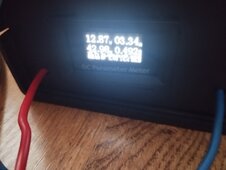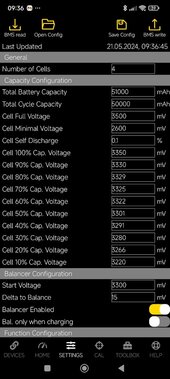I know very well how many topics have already been created here. Will it be wrong if I add another one? I don't want to litter your discussions by contributing to other threads. I wanted to ask about some differences that arise when measuring current voltage. My bms on a 12V 50Ah battery, indicates a value of 13.65V as the final charging voltage, actually 99%. While the meters indicate much higher, like 13.9V and 14.1V Leaving aside the accuracy of the instruments and the voltage drop on the wires and connections, I was sure that the voltage on a single cell, can reach a value of 3.5V at almost full charge, and here it comes out 3.41V One of my meters is a Chinese DC meter and I generally trust it, because it indicates accurate voltages for reference. Having 14.1V on it, the BMS indicates 13.65V I don't really get much by it. I apologize if what I wrote is not entirely understandable, but I'm still propping up the translator.
You are using an out of date browser. It may not display this or other websites correctly.
You should upgrade or use an alternative browser.
You should upgrade or use an alternative browser.
True voltages of current inside and outside - Which is correct?
- Thread starter beo
- Start date
Q-Dog
¯\_(ツ)_/¯
Do you have a hand held multi meter for testing?
I have one ampere meter analog, and two mutlimetr digitalCzy masz ręczny multimetr do testów?
Q-Dog
¯\_(ツ)_/¯
Does the hand held multi meter verify the voltages you see on the BMS?
No. I have only external connectors available. That battery is closed, and now I don't want open it because I would have to forcibly open. I have information from BMS on bluetooth.
an interesting thing is the lack of indication by the BMS bluetooth of the consumption of amperes when the current drawn is less than 2 amperes
an interesting thing is the lack of indication by the BMS bluetooth of the consumption of amperes when the current drawn is less than 2 amperes
Last edited:
Q-Dog
¯\_(ツ)_/¯
Don't worry about individual battery cells for now. Does the total battery voltage on the BMS match what you get on your multi meter?
Maybe you have a loose connection?
Maybe you have a loose connection?
Information sent from BMS coincides with multimeter when battery it is at rest, or discharging. The connections I do not know inside. The battery is under warranty, so I don't want to open it for now. I'm not sure whether I can trust a Polish seller or, however, communicate with a Chinese seller who seems to care more about his reputation
Last edited:
Your BMS should be reporting accurate voltages. Here is a screenshot of my BMS along with a shot of the shunt (round display) and my solar charger. The shunt is a little low but I call it close enough.
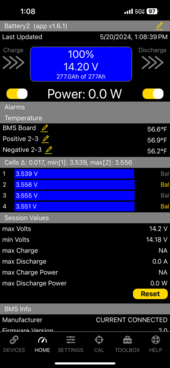
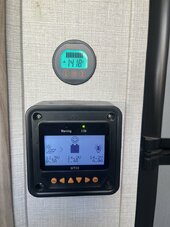
This is in the charged 100% SOC condition so there isn't any voltage drop from the cables. My VOM measures the same voltage so I'm pretty confident with its accuracy.


This is in the charged 100% SOC condition so there isn't any voltage drop from the cables. My VOM measures the same voltage so I'm pretty confident with its accuracy.
Attachments
@TacomaJoe And does your current voltage go up equally in the application and OVM? I am just about to run out of current in my battery and will start charging before noon to observe the process more closely. However, I intend to get the protection from both extremes to work
profesor79
...
Voltage measuremnt is a fun, and somtimes latency in my BMS refresh does not sum up, when taking all cells voltage.
As long as the voltages are in range 2.8 - 3.65 V per cell, then all is good. If you have a way to charge and discharge your battery in controlled way, then imho that will allow to validade BMS ability to protect cells.
As long as the voltages are in range 2.8 - 3.65 V per cell, then all is good. If you have a way to charge and discharge your battery in controlled way, then imho that will allow to validade BMS ability to protect cells.
This is how I can control discharge and recharge the battery, because for the moment, it is intended as a power reserve.
Now it looks like in the screenshots. There is also a voltage difference when discharging. Unfortunately, yesterday I again unwillingly used the BMS record and the SOC in the application was heavily reduced from 52%.
@TacomaJoe Have you perhaps compared my settings from the screen shot at the beginning of the bms settings in the OverkillSolar apllication? Maybe that's the problem? In my case e.g. Cell 100% Cap.voltage 3350mV A should probably be 3650mV?
ooo sorry. I attached screen in other topic... Ok I update this too
It appears that the battery has a larger capacity than declared, because by now, I have calculated 52Ah at a current voltage of 12.68V. So either the manufacturer belatedly reduced the capacity on sale, since the earlier one has already worn out, or the BMS is miscalibrated. It is possible that the cells used have 80% of their nominal capacity.... I drew the wrong conclusion. I was adding the current capacity, to the counted total, and yet it is not so. The total capacity up to now is 46Ah at 12.54V. So it looks like simply, the BMS is not well calibrated
Now it looks like in the screenshots. There is also a voltage difference when discharging. Unfortunately, yesterday I again unwillingly used the BMS record and the SOC in the application was heavily reduced from 52%.
@TacomaJoe Have you perhaps compared my settings from the screen shot at the beginning of the bms settings in the OverkillSolar apllication? Maybe that's the problem? In my case e.g. Cell 100% Cap.voltage 3350mV A should probably be 3650mV?
ooo sorry. I attached screen in other topic... Ok I update this too
It appears that the battery has a larger capacity than declared, because by now, I have calculated 52Ah at a current voltage of 12.68V. So either the manufacturer belatedly reduced the capacity on sale, since the earlier one has already worn out, or the BMS is miscalibrated. It is possible that the cells used have 80% of their nominal capacity.... I drew the wrong conclusion. I was adding the current capacity, to the counted total, and yet it is not so. The total capacity up to now is 46Ah at 12.54V. So it looks like simply, the BMS is not well calibrated
Last edited:
profesor79
...
It is a normal case for LifePo4 batteries that the starting capacity is higher than nominal.It appears that the battery has a larger capacity than declared, because by now, I have calculated 52Ah at a current voltage of 12.68V. So either the manufacturer belatedly reduced the capacity on sale, since the earlier one has already worn out, or the BMS is miscalibrated. It is possible that the cells used have 80% of their nominal capacity.... I drew the wrong conclusion. I was adding the current capacity, to the counted total, and yet it is not so. The total capacity up to now is 46Ah at 12.54V. So it looks like simply, the BMS is not well calibrated
Right now I see capacity is 52.6Ah when voltage 12.15V From what it seems to me, the cutoff voltage should occur at 10.5V I will then see what voltages the application will present for a single cell. It will perhaps be known what calibration is required.
Edit: So from 11.65V the voltage starts to drop steeply, so it looks like I'm rapidly approaching the voltage limit.
End discharge is 10.8V I see in the application that in this lower limit the 3rd cell has the lowest voltage of 2.728V The voltage on this cell dropped the fastest, which probably influenced the disconnection of the discharge. Is the balance setting at 3.3V OK? And does this balancing work while charging or while the battery is at rest? Currently the resting voltage, coincides with the voltage on the multimeter.
Now I charge 3Amp, and the difference between the BMS-application and the multimeter is 100mV. This is acceptable, because the wires themselves are most likely to cause a voltage drop
Edit: So from 11.65V the voltage starts to drop steeply, so it looks like I'm rapidly approaching the voltage limit.
End discharge is 10.8V I see in the application that in this lower limit the 3rd cell has the lowest voltage of 2.728V The voltage on this cell dropped the fastest, which probably influenced the disconnection of the discharge. Is the balance setting at 3.3V OK? And does this balancing work while charging or while the battery is at rest? Currently the resting voltage, coincides with the voltage on the multimeter.
Now I charge 3Amp, and the difference between the BMS-application and the multimeter is 100mV. This is acceptable, because the wires themselves are most likely to cause a voltage drop
Last edited:
Here are my settings.

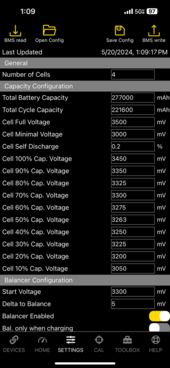


I have my balance starting at 3300mV with 5mV delta because I a cell that would run at the top and trigger cell over voltage. The normal numbers are 3400mV and 15mV. On my other batteries. This battery is resting at 14.2V because that is the float setting of my solar charger. At night, I have less that 1A drain and it brings it down to 13.3V but still shows 100%.
The BMS should display low currents. This morning I checked mine and it showed 0.8A discharge (while my shunt showed 0.737A). This is the minimum load with my trailer to run the 12V control boards and carbon monoxide tester. I turned the discharge OFF for my other two batteries so that the load was on just this one BMS and when I turned those back ON, the SOC was 75% because the BMS will guess at the number when you make changes to the settings.
Your found the fast drop when discharging, same thing happens at the top when charging. There is a large voltage change with only a little charge or discharge current.




I have my balance starting at 3300mV with 5mV delta because I a cell that would run at the top and trigger cell over voltage. The normal numbers are 3400mV and 15mV. On my other batteries. This battery is resting at 14.2V because that is the float setting of my solar charger. At night, I have less that 1A drain and it brings it down to 13.3V but still shows 100%.
The BMS should display low currents. This morning I checked mine and it showed 0.8A discharge (while my shunt showed 0.737A). This is the minimum load with my trailer to run the 12V control boards and carbon monoxide tester. I turned the discharge OFF for my other two batteries so that the load was on just this one BMS and when I turned those back ON, the SOC was 75% because the BMS will guess at the number when you make changes to the settings.
Your found the fast drop when discharging, same thing happens at the top when charging. There is a large voltage change with only a little charge or discharge current.
Thank you very much! I have similar settings to yours, so it seems correct. So I assume that my cells can belong to grade B. So all the more reason for me to keep an eye on the limits. This is my first battery with slightly higher capacity. I also have a smaller 20Ah, but without smart bms. So it's time to stop bothering with the small stuff. The battery has capacity, but it is not fully operational, and this I must understand
I contacted the seller and received assurances that all his batteries are assembled on Grade A cells from EVE most often. As he stated, nothing prevents me from looking inside and evaluating for myself. For me in this case, the man is fine and is not hiding anything.
At the same time it seems that the indicated voltage in the application, is shown on the basis of the entered data of the current voltage of individual cells.In this way it can be adjusted to the actual conditions. I understand that these settings should not be in accordance with the limits of possibility? however, wants to try to apply the limits of the settings, for more accurate calibration. Am I doing the wrong thing?
I suspect that the vendor did not pay much attention to the settings in the app. Now all the voltages agree with me between the app and the multimeters only the capacity deviates from the norm, because at the moment the shunt multimeter calculated 56Ah at 13.9V
So sure enough, entered voltage values for the current capacitance, does not cause any physical changes.
@TacomaJoe If I change the current voltage values of individual cells, will this affect the operation of the BMS protection, or only the displayed value of the overall voltage, and the bms works independently?
At the same time it seems that the indicated voltage in the application, is shown on the basis of the entered data of the current voltage of individual cells.In this way it can be adjusted to the actual conditions. I understand that these settings should not be in accordance with the limits of possibility? however, wants to try to apply the limits of the settings, for more accurate calibration. Am I doing the wrong thing?
I suspect that the vendor did not pay much attention to the settings in the app. Now all the voltages agree with me between the app and the multimeters only the capacity deviates from the norm, because at the moment the shunt multimeter calculated 56Ah at 13.9V
So sure enough, entered voltage values for the current capacitance, does not cause any physical changes.
@TacomaJoe If I change the current voltage values of individual cells, will this affect the operation of the BMS protection, or only the displayed value of the overall voltage, and the bms works independently?
Last edited:
profesor79
...
do you know what BMS is inside?
if that is a cheap device - i will not take care of cycle count, as long as this BMS can prevent overcharge and overdischarge.
if that is a cheap device - i will not take care of cycle count, as long as this BMS can prevent overcharge and overdischarge.
mikefitz
Solar Wizard
- Joined
- May 28, 2020
- Messages
- 3,098
If this is occurring when chargers are connected to the battery then its probable the battery is fully or near full charged, the BMS has detected cell overvolts and shut down the charge path. The voltage difference you are seeing is the drop across the 'off' BMS.indicates a value of 13.65V as the final charging voltage, actually 99%. While the meters indicate much higher, like 13.9V and 14.1V
Once the chargers are no longer active, ( or the battery is loaded), the voltage falls below the recovery volts and the BMS fully restores the charge and discharge parh.
At all times the BMS indicates the voltage sum across the cells, not the voltage at the battery terminals.
To prevent BMS entering protection, lower the charge volts and set the chargers to apply this charge volts for several hours to alow the cells to balance. Almost all new, ready built, batteries will have cell inbalance.
Similar threads
- Replies
- 8
- Views
- 497
- Replies
- 8
- Views
- 427
- Replies
- 54
- Views
- 1K
- Replies
- 8
- Views
- 596




